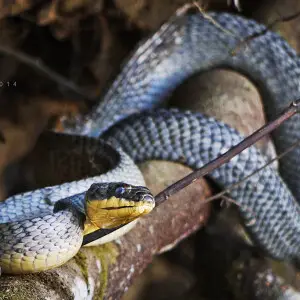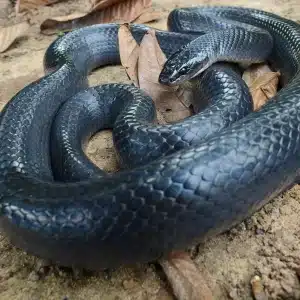[
Costa Rica is sold to the world with images of surf breaks, volcano skylines, coffee farms and ceviche by the sea – but the same lush landscape that draws beach lovers, foodies, real estate hunters and business investors is also home to some seriously fascinating wildlife. Beyond the howler monkeys and scarlet macaws, there’s a quiet, hard-working hero of the undergrowth: a sleek blue snake that eats some of the country’s most dangerous vipers. Meet the mussurana, or as most Ticos call it, the zopilota.
What is the mussurana snake in Costa Rica?
The mussurana is a medium-sized, rear-fanged snake that ranges from Guatemala down to Brazil and is regularly found in many parts of Costa Rica.
Also known locally as zopilota, this species (Clelia clelia) belongs to the colubrid family and spends much of its life hidden in dense ground-level vegetation, quietly patrolling the forest floor. For most visitors and even many locals, it’s an invisible neighbour, but its role in the ecosystem is huge – especially if you’re not a fan of venomous snakes.
-
Scientific name: Clelia clelia
-
Family: Colubridae
-
Local name in Costa Rica: zopilota
-
Range: Guatemala to Brazil, including Costa Rica
How big does a mussurana grow?
A mussurana usually grows to around 1.5 to 1.6 metres, but the largest females can reach an impressive 2.4 metres.
These snakes are long, smooth and muscular rather than heavy-bodied, built for sliding through thick undergrowth and wrestling other snakes. Females tend to be larger than males, giving them an advantage when tackling sizeable prey.
-
Average adult length: 1.5–1.6 m (4.9–5.2 ft)
-
Maximum recorded length: about 2.4 m (7.9 ft)
-
Females: generally longer and more robust than males
What does a mussurana look like at each life stage?
Mussuranas start life pink and cream before maturing into a sleek, lead-blue adult snake.
Hatchlings and juveniles have a striking appearance, with a light pink dorsal surface and a whitish-yellow underside. As they grow, that pastel palette shifts into a sophisticated bluish-grey that helps them disappear into the shadows on the forest floor. Like many Costa Rican reptiles, they are egg-laying, with the next generation hatching out ready to join the undergrowth patrol.
What do Mussuranas eat?
Mussuranas are specialist snake eaters that mainly prey on other snakes, especially venomous pit vipers.
Armed with 10 to 15 strong teeth at the back of the mouth, they seize the head of their victim, then coil their body around it and kill by constriction. Once swallowed, the prey’s long body is slowly “wave-pushed” through the mussurana’s digestive system.
Typical mussurana menu:
-
Venomous pit vipers (their favourite food)
-
Other non-venomous snakes
-
Small mammals (when snakes are scarce)
They are remarkably immune to the venom of most of the snakes they eat, particularly pit vipers, but they are not immune to coral snake venom. Even a super-snake has limits.
Are mussuranas dangerous to humans?
Mussuranas are considered harmless to humans, as they are shy, mildly venomous and reluctant to bite.
They are rear-fanged, meaning their fangs sit further back in the mouth, making it hard to deliver venom unless they manage to chew for some time – which they almost never try with people. Even when handled, they rarely strike, and recorded human bites are extremely rare and non-fatal. For hikers, farmers and adventure travellers, the mussurana is more friend than foe.
Key safety points:
-
Rear-fanged and mildly venomous
-
Very reluctant to bite
-
Envenomation is difficult and unlikely
-
No fatal human cases reported
Why do farmers and scientists value the mussurana?
Farmers value the mussurana as a natural pest controller of dangerous pit vipers, and scientists study it for its venom immunity.
In some rural areas, farmers even keep mussuranas around barns and fields to help protect livestock from venomous snakes. In Brazil, large-scale breeding and release programmes were once attempted to control pit viper populations. The scheme didn’t fully succeed, but it showed just how useful this snake can be as a natural form of “biological control”.
Researchers have also studied the mussurana’s immunity to pit viper venom, hoping to better understand antivenom production. The famous Butantan Institute in São Paulo – a global centre for antivenins – even erected a statue of the mussurana as a tribute to its role in the fight against venomous snake bites.
Are mussuranas becoming rare in Costa Rica and beyond?
Mussurana populations are declining in many regions because their prey and habitats are disappearing.
As forests are cleared, ground vegetation is trampled, and ecosystems are simplified, both venomous snakes and their predators lose the complex habitat they need. With fewer snakes to eat – and fewer safe pockets of dense cover – mussuranas are becoming increasingly hard to find, and in some areas they are close to disappearing.
Their story is a reminder that every piece of Costa Rica’s wild puzzle matters: from jungle trails enjoyed by tourists, to farms, housing developments and business projects that share space with hidden hunters under the leaves. Protect the habitat and you protect the silent blue guardian that keeps the balance.
FAQ about the mussurana (zopilota)
Is the mussurana found all over Costa Rica?
It is found in many parts of Costa Rica, especially where there is dense ground-level vegetation and healthy snake populations.
Does the mussurana only eat snakes?
Mostly yes; snakes, especially pit vipers, are its main prey, but it will also eat small mammals when snakes are hard to find.
Can a mussurana kill a fer-de-lance?
Yes, mussuranas are known to prey on pit vipers such as fer-de-lance and have a strong resistance to their venom.
Is it legal to keep a mussurana as a pet in Costa Rica?
Wildlife laws in Costa Rica are strict; keeping native wildlife as pets is usually not allowed without special permits. Always check current regulations.
Why should travellers care about mussuranas?
Because they help keep dangerous snake numbers under control and are part of the rich, interconnected wildlife that makes Costa Rica such a unique place to live, visit, invest and explore.
Costa Rica’s adventure isn’t only in the surf, the nightlife or the latest real estate project overlooking the Pacific; it’s also in the quiet stories unfolding under your boots on a jungle trail or at the edge of a farm. The mussurana may never star in glossy tourism ads or foodie videos, but this elegant, blue-grey snake is working behind the scenes so people, livestock and wild landscapes can thrive together. Next time you plan a business move, a property viewing or a foodie road trip through the country, remember there’s a silent ally in the grass, doing its part for the Pura Vida you came to find.
HOWLER Monkey
Bullet Ants, Pain You Don’t Want to Feel
Tree Boas
Toucan Species
Jaguars: Cool Cat has crucial Place in Ecosystem
Coati
Leatherbacks: a close-to-home concern
A Unique Mix of Animals in Costa Rica
The Costa Rican Coral Snake









